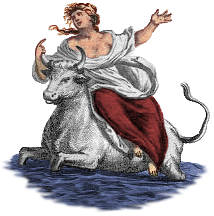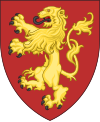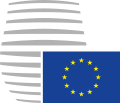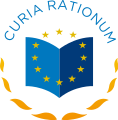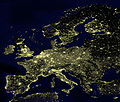
Back بوابة:الاتحاد الأوروبي Arabic Portal:Avropa İttifaqı Azerbaijani প্রবেশদ্বার:ইউরোপীয় ইউনিয়ন Bengali/Bangla Portal:Unió Europea Catalan Portál:Evropská unie Czech Portal:Den Europæiske Union Danish Portal:Europäische Union German Πύλη:Ευρωπαϊκή Ένωση Greek Portal:Unión Europea Spanish Teemasivu:Euroopan unioni Finnish
Introduction
The European Union (EU) is a supranational political and economic union of 27 member states that are located primarily in Europe. The Union has a total area of 4,233,255 km2 (1,634,469 sq mi) and an estimated total population of over 448 million. The EU has often been described as a sui generis political entity (without precedent or comparison) combining the characteristics of both a federation and a confederation. Containing 5.8% of the world population in 2020, EU member states generated a nominal gross domestic product (GDP) of around US$16.6 trillion in 2022, constituting approximately one sixth of global nominal GDP. Additionally, all EU states except Bulgaria have a very high Human Development Index according to the United Nations Development Programme. Its cornerstone, the Customs Union, paved the way to establishing an internal single market based on standardised legal framework and legislation that applies in all member states in those matters, and only those matters, where the states have agreed to act as one. EU policies aim to ensure the free movement of people, goods, services and capital within the internal market; enact legislation in justice and home affairs; and maintain common policies on trade, agriculture, fisheries and regional development. Passport controls have been abolished for travel within the Schengen Area. The eurozone is a group composed of the 20 EU member states that have fully implemented the economic and monetary union and use the euro currency. Through the Common Foreign and Security Policy, the union has developed a role in external relations and defence. It maintains permanent diplomatic missions throughout the world and represents itself at the United Nations, the World Trade Organization, the G7 and the G20. Due to its global influence, the European Union has been described by some scholars as an emerging superpower. In 2012, the EU was awarded the Nobel Peace Prize. The United Kingdom became the only member state to leave the EU, in 2020; ten countries are aspiring or negotiating to join it. (Full article...) Selected article The Maserati MC12 is a grand tourer produced by Maserati to allow a racing variant to compete in the FIA GT Championship. The car entered production in 2004 with 25 cars produced. A further 25 were produced in 2005 making a total of 50 cars available for customers, all of which were pre-sold for €600 000. Maserati designed and built the car on the chassis of the Enzo Ferrari but the final car is much larger. The MC12 is longer, wider and taller than the Enzo Ferrari, however the Enzo has faster acceleration and a higher top speed. The MC12 was developed to signal Maserati's return to racing after 37 years. The road version was produced to homologate the race version. One of the requirements for participation in the FIA GT is the production of at least 25 road cars. Three GT1 race cars were entered into the FIA GT with great success. Maserati began racing the MC12 in the FIA GT toward the end of the 2004 season, achieving a victory at the Zhuhai International Circuit. Selected picturePhoto credit: Massimo Catarinella The Keizersgracht ("Emperor's Canal" in Dutch), the widest of the three major canals of Amsterdam, at dusk. Located in the city centre, it is named after Maximilian I, Holy Roman Emperor. The more than one hundred kilometers of canals in Amsterdam, about 90 islands and 1,500 bridges have led the city to being termed the "Venice of the North".
Did you know?... that the presidency of the EU Council rotates every half year? ... that the EU parliamentary election is the world's biggest transnational election? ... that the European Union was awarded the Nobel Peace Prize in 2012? Selected cityValletta, population 6,444 (2014), is the capital city of Malta. The whole city was inscribed as a UNESCO World Heritage Site in 1980. The official name the Order of Saint John gave to the city was Humilissima Civitas Valletta — a city bound to humility. However, with the building of bastions, curtains and ravelins, along with the beauty of the baroque buildings along its streets, it became known as Superbissima — 'Most Proud', amongst the ruling houses of Europe. In Maltese it is known as Il-Belt, simply meaning "The City". The foundation stone of Valletta was laid by the Grandmaster of the Order of Saint John, Jean Parisot de Valette, on 28 March 1566; The Order decided to found a new city on the Xiberras peninsula just after the end of the Great Siege of Malta in 1565, so as to fortify the Order's position in Malta, effectively binding the Knights to the island. The city was designed by Francesco Laparelli, while many of the most important buildings were built by Girolamo Cassar. Valletta, hence, is an urban area which boasts many buildings from the 16th century and onwards, but most of them were built during the time of the Knights of St. John of Jerusalem (the Knights Hospitaller, or Knights of Malta). General imagesThe following are images from various European Union-related articles on Wikipedia.
TopicsFeatured contentFeatured articles
Featured lists
Featured contentGood articles
CategoriesRelated portalsAssociated WikimediaThe following Wikimedia Foundation sister projects provide more on this subject:
Discover Wikipedia using portals |
© MMXXIII Rich X Search. We shall prevail. All rights reserved. Rich X Search


